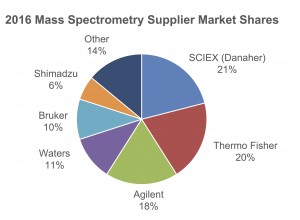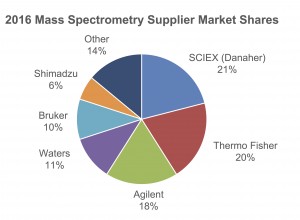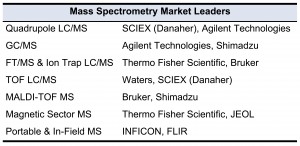Mass Spectrometry: Momentum Continues
With 2016 sales of $3.8 billion, the mass spectrometry (MS) market is on track for solid growth this year, buoyed by new innovations and detection capabilities across several vendors’ product lines. The market is expected to grow 6.8% in 2017, fueled by applications in life science, food safety and clinical research. Service revenue is anticipated to outpace initial systems and the aftermarket.
Quadrupole LC/MS demand accounts for about one-third of the MS market. Its sales are expected to grow at a healthy rate during 2017, driven by triple quadrupole systems. Clinical research and pharmaceutical development will continue to be major sources of revenue, while an increase in outsourcing to contract research labs is also expected to benefit the market. Danaher’s SCIEX subsidiary and Agilent Technologies remain the top two suppliers of this technology.
In 2017, the GC/MS market will experience moderate growth, driven by strength in demand from environmental labs and food testing applications, offset by weakness in the oil and gas, and chemical industries. However, its bright areas will be the continued popularity of Q-TOF and triple quadrupole systems, which offer high-resolution capabilities. By far, the leading vendor in this space is Agilent.
A decline in demand is predicted for ion trap LC/MS, as its sales will continue to be cannibalized by triple quadrupole LC/MS and Orbitrap systems. Sold by Thermo Fisher Scientific, demand for Orbitrap systems is likely to grow quite well this year, propelled in part by increasing affordability.
The TOF LC/MS market is expected to grow 6.4% this year, driven by increasing demand for Q-TOF units. Since this technology is known for offering better mass accuracy, resolution and mass range than quadrupole LC/MS, it is a preferred technology for structural analysis, and the screening of unknowns for proteins and peptides. As such, growth from the pharmaceutical and biotechnology sector will be quite robust. The market remains dominated by SCIEX (Danaher) and Waters.
Sales growth for MALDI-TOF is also likely to be robust in 2017, with demand driven by the increased usage of these systems in clinical applications. In particular, as antibiotic resistance becomes a major concern, MALDI-TOF will continue to provide an efficient alternative to traditional methods of culturing and identifying bacteria. The market is dominated by Bruker and Shimadzu.
INFICON, FLIR and Bruker are the top vendors of portable and in-field MS. Sales for this technology segment continue to flourish, driven largely by security applications in various government departments. Growth for this market in 2017 is expected to be strong, particularly as the technology lends itself to new applications in the agriculture and food industries.
Thermo Fisher has a strong foothold in the magnetic sector market but, since the technology is quite mature and obsolete in most applications, growth is expected to remain flat.







